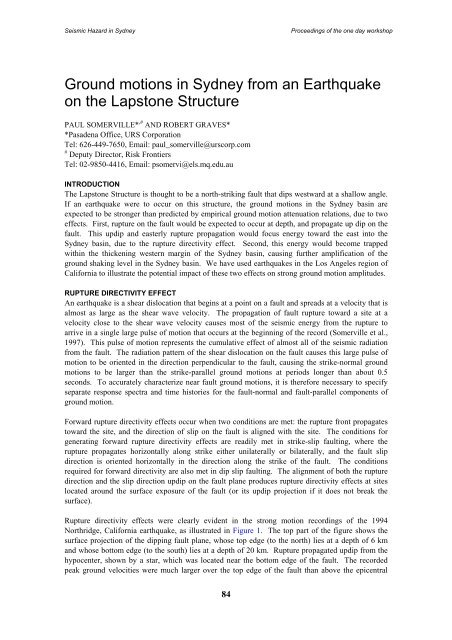Landslides in the Sydney Basin - Geoscience Australia
Landslides in the Sydney Basin - Geoscience Australia
Landslides in the Sydney Basin - Geoscience Australia
- No tags were found...
You also want an ePaper? Increase the reach of your titles
YUMPU automatically turns print PDFs into web optimized ePapers that Google loves.
Seismic Hazard <strong>in</strong> <strong>Sydney</strong>Proceed<strong>in</strong>gs of <strong>the</strong> one day workshopGround motions <strong>in</strong> <strong>Sydney</strong> from an Earthquakeon <strong>the</strong> Lapstone StructurePAUL SOMERVILLE* ,# AND ROBERT GRAVES**Pasadena Office, URS CorporationTel: 626-449-7650, Email: paul_somerville@urscorp.com# Deputy Director, Risk FrontiersTel: 02-9850-4416, Email: psomervi@els.mq.edu.auINTRODUCTIONThe Lapstone Structure is thought to be a north-strik<strong>in</strong>g fault that dips westward at a shallow angle.If an earthquake were to occur on this structure, <strong>the</strong> ground motions <strong>in</strong> <strong>the</strong> <strong>Sydney</strong> bas<strong>in</strong> areexpected to be stronger than predicted by empirical ground motion attenuation relations, due to twoeffects. First, rupture on <strong>the</strong> fault would be expected to occur at depth, and propagate up dip on <strong>the</strong>fault. This updip and easterly rupture propagation would focus energy toward <strong>the</strong> east <strong>in</strong>to <strong>the</strong><strong>Sydney</strong> bas<strong>in</strong>, due to <strong>the</strong> rupture directivity effect. Second, this energy would become trappedwith<strong>in</strong> <strong>the</strong> thicken<strong>in</strong>g western marg<strong>in</strong> of <strong>the</strong> <strong>Sydney</strong> bas<strong>in</strong>, caus<strong>in</strong>g fur<strong>the</strong>r amplification of <strong>the</strong>ground shak<strong>in</strong>g level <strong>in</strong> <strong>the</strong> <strong>Sydney</strong> bas<strong>in</strong>. We have used earthquakes <strong>in</strong> <strong>the</strong> Los Angeles region ofCalifornia to illustrate <strong>the</strong> potential impact of <strong>the</strong>se two effects on strong ground motion amplitudes.RUPTURE DIRECTIVITY EFFECTAn earthquake is a shear dislocation that beg<strong>in</strong>s at a po<strong>in</strong>t on a fault and spreads at a velocity that isalmost as large as <strong>the</strong> shear wave velocity. The propagation of fault rupture toward a site at avelocity close to <strong>the</strong> shear wave velocity causes most of <strong>the</strong> seismic energy from <strong>the</strong> rupture toarrive <strong>in</strong> a s<strong>in</strong>gle large pulse of motion that occurs at <strong>the</strong> beg<strong>in</strong>n<strong>in</strong>g of <strong>the</strong> record (Somerville et al.,1997). This pulse of motion represents <strong>the</strong> cumulative effect of almost all of <strong>the</strong> seismic radiationfrom <strong>the</strong> fault. The radiation pattern of <strong>the</strong> shear dislocation on <strong>the</strong> fault causes this large pulse ofmotion to be oriented <strong>in</strong> <strong>the</strong> direction perpendicular to <strong>the</strong> fault, caus<strong>in</strong>g <strong>the</strong> strike-normal groundmotions to be larger than <strong>the</strong> strike-parallel ground motions at periods longer than about 0.5seconds. To accurately characterize near fault ground motions, it is <strong>the</strong>refore necessary to specifyseparate response spectra and time histories for <strong>the</strong> fault-normal and fault-parallel components ofground motion.Forward rupture directivity effects occur when two conditions are met: <strong>the</strong> rupture front propagatestoward <strong>the</strong> site, and <strong>the</strong> direction of slip on <strong>the</strong> fault is aligned with <strong>the</strong> site. The conditions forgenerat<strong>in</strong>g forward rupture directivity effects are readily met <strong>in</strong> strike-slip fault<strong>in</strong>g, where <strong>the</strong>rupture propagates horizontally along strike ei<strong>the</strong>r unilaterally or bilaterally, and <strong>the</strong> fault slipdirection is oriented horizontally <strong>in</strong> <strong>the</strong> direction along <strong>the</strong> strike of <strong>the</strong> fault. The conditionsrequired for forward directivity are also met <strong>in</strong> dip slip fault<strong>in</strong>g. The alignment of both <strong>the</strong> rupturedirection and <strong>the</strong> slip direction updip on <strong>the</strong> fault plane produces rupture directivity effects at siteslocated around <strong>the</strong> surface exposure of <strong>the</strong> fault (or its updip projection if it does not break <strong>the</strong>surface).Rupture directivity effects were clearly evident <strong>in</strong> <strong>the</strong> strong motion record<strong>in</strong>gs of <strong>the</strong> 1994Northridge, California earthquake, as illustrated <strong>in</strong> Figure 1. The top part of <strong>the</strong> figure shows <strong>the</strong>surface projection of <strong>the</strong> dipp<strong>in</strong>g fault plane, whose top edge (to <strong>the</strong> north) lies at a depth of 6 kmand whose bottom edge (to <strong>the</strong> south) lies at a depth of 20 km. Rupture propagated updip from <strong>the</strong>hypocenter, shown by a star, which was located near <strong>the</strong> bottom edge of <strong>the</strong> fault. The recordedpeak ground velocities were much larger over <strong>the</strong> top edge of <strong>the</strong> fault than above <strong>the</strong> epicentral84
















